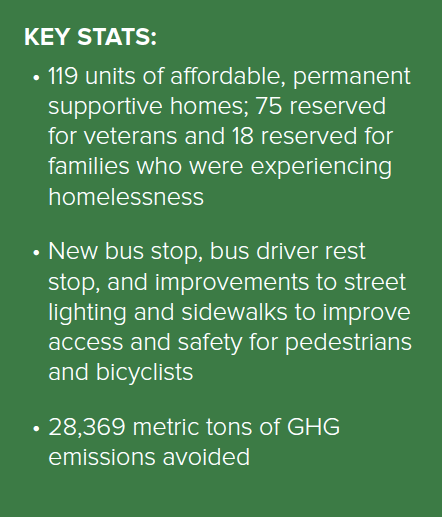The Affordable Housing and Sustainable Communities program was formulated in 2014 to solve multiple statewide problems. Its ambitious aims are to build much-needed affordable housing that makes it easy and inexpensive for its residents to get where they need to go without relying on cars. One of the program's main goals is to help reduce greenhouse gas emissions, which makes it eligible for funding from the state's cap-and-trade system.
To achieve its goals, the AHSC pushes organizations and agencies in different sectors to coordinate with each other. It funds housing, and also bike and pedestrian pathways and crossings, improvements to transit services, stops, and station areas, and transit passes for residents.
The program also aims to prevent displacement, which is a particular problem in transit-rich areas where rising housing prices can force out existing tenants. So on top of building more affordable housing, the AHSC encourages the adoption of tenant protection policies, robust outreach to disadvantaged communities, and workforce development and hiring strategies.
It also encourages "climate resiliency strategies" to help communities prepare for the impacts of climate change. That includes planting trees to mitigate heat islands, building storm water management infrastructure, and creating drought-tolerate landscaping.
Nothing big about this little program's ambition - just aiming to solve all the problems, that’s all. It puts into practice what California has been trying, and failing, to do for years: connect planning for housing to planning how people will get to and from that housing.
It’s too much to ask from one program. But it is succeeding, according to the annual report just released by Enterprise Community Partners and the California Housing Partnership, two organizations that helped formulate and run the program in conjunction with the Strategic Growth Council.
In the first four rounds of awards, the AHSC invested $1.1 billion towards:
- 101 integrated affordable housing and transportation developments across California, many of which directly benefit disadvantaged and low-income communities
- 8,933 new affordable homes
- 158 miles of new and improved bike lanes
- 1,000 new and improved crosswalks
- 222 new buses, vans, shuttles
- 7,800 transit passes
- 21,000 jobs during construction alone, supporting about 6,000 permanent jobs
- $1.7 billion in wages and business income
- $666 million in state and local tax revenue
- 2.2 million metric tons of GHG avoided
- 15,600 cars removed from the road
- 181 million fewer miles driven
- "hundreds of millions" in wages, business income, local and state tax revenue
The report's authors estimate that the latest round of AHSC awards alone will save residents of its projects--and of their surrounding communities--more than $550 million from switching from driving to riding mass transit, biking, or walking. But the cost savings are just a side benefit of the program's focus to reduce greenhouse gases. Using calculators created by the Air Resources Board, the authors estimate that the developments and investments funded by the AHSC will bring a substantial reduction in greenhouse gases.

"By requiring coordination of housing, transportation, and land use planning," write the authors, "AHSC simultaneously and holistically addresses three of California’s most pressing challenges: housing affordability, transportation infrastructure, and climate change mitigation.... AHSC’s success stems in part from the deep partnerships and coordination it has fostered among affordable housing developers, transit agencies, local governments, and community organizations and residents."
"The idea behind this report is to help bring home some of the holistic, multi-sector impacts of the AHSC," said Justine Marcus of Enterprise Community Partners.
“This year’s report is unique because we were able to incorporate the perspectives of residents living in AHSC-funded developments that are now open," said Marcus. "Hearing directly from Californians, in their own words, shines a light on what this program means for families searching for the peace of mind and opportunity that come from having a stable, quality, affordable home with easy access to the places they need to go.”
California needs more than 1.4 million new affordable homes to meet the needs of its lowest income renters. The AHSC, which is one of few sources of affordable housing funding in the state, will produce almost 9,000 new units with these four rounds of funding. That's a mere drop in the bucket of what's needed. At the same time, the developments this program is encouraging, and producing, are the kinds of developments California needs most.
Meanwhile, the Greenhouse Gas Reduction Fund, which has allocated twenty percent of annual cap-and-trade revenue to the AHSC up until this point, will undergo changes to its structure in the next few years. That may affect how much funding the AHSC receives, or even whether it gets funded at all in the future.






